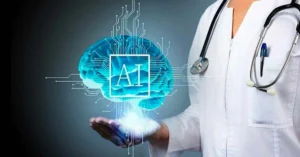In the digital age, companies and individuals attach great importance to data. However, as the amount of data increases and cyber attacks become more sophisticated, protecting this data is more difficult than ever. Artificial intelligence can detect, analyze and respond to security threats. This article discusses the impact of artificial intelligence on threat detection, its advantages, disadvantages and capabilities.
Artificial Intelligence Detection:
Today’s threat detection relies on artificial intelligence to instantly analyze large amounts of data and detect trends and anomalies. Traditional security systems use predefined rules and signatures to detect threats, but new or emerging threats may not be detected. However, artificial intelligence uses machine learning algorithms to learn from data and adapt to new hazard patterns, increasing its detection capabilities. Artificial intelligence is especially good at detecting zero-day attacks and advanced cyber threats that can bypass traditional security procedures.
Benefits of Artificial Intelligence Threat Detection:
There are many benefits to using artificial intelligence in hazard detection. Processing and analyzing large amounts of data at record speeds is a major advantage. Artificial intelligence algorithms can detect hazards in seconds through millions of data points. Human analysts take longer. Fast analysis reduces the opportunity for the attacker by speeding up response times.
Another benefit is the accuracy of AI-driven threat detection. Even in the absence of obvious signs, AI systems can detect subtle trends and anomalies that could indicate a threat. This eliminates false positives and quickly detects and resolves real threats. Artificial intelligence can detect and respond to hazards in real time through continuous monitoring and analysis.
Artificial intelligence accelerates threat detection by automating annoying actions. Instead of having to sift through vast amounts of information, security analysts can investigate and mitigate threats. This increases productivity and addresses the cybersecurity skills gap.
Artificial Intelligence Threat Detection Practice:
Artificial intelligence improves threat detection and data protection in real-world applications. Artificial intelligence technology can detect fraud and money laundering in financial transactions. Real-time analysis of trading patterns helps detect fraud and prevent financial losses.
Artificial intelligence monitors network traffic and detects illegal access to patient data in healthcare. Artificial intelligence systems can protect patient data by detecting unusual patterns of data access and alerting security professionals to suspected violations.
Endpoint security solutions use artificial intelligence to protect devices against malware and other online threats. These solutions use artificial intelligence to detect malicious device behavior and prevent infections. This is critical as the increasing number of connected devices increases the attack surface for cyber threats.
Challenges in Detecting AI Threats:
AI threat detection has many advantages, but also disadvantages. The quality and availability of data are major problems. Artificial intelligence systems use large data sets to learn and make predictions. If these systems are trained with insufficient or biased data, artificial intelligence can produce inaccurate results. Artificial intelligence-based threat detection requires high-quality, representative data.
Hostile attacks are another problem. Cyber attackers can manipulate data or exploit flaws in machine learning algorithms to trick artificial intelligence systems. This can lead to false positives and false negatives, where benign behavior is wrongly perceived as a threat. Developing artificial intelligence systems that can withstand hostile attacks is critical to cybersecurity research.
We also have problems with interpretability and transparency. Artificial intelligence systems, especially deep learning systems, can be “black boxes,” making their judgments difficult to understand. Threat detection relies on understanding the choices of AI systems, so a lack of transparency can hinder incident response. To solve this problem, explainable artificial intelligence models and explainable artificial intelligence methods are needed.
The Future of Artificial Intelligence Threat Detection:
As technology advances, AI threat detection has enormous prospects. Machine learning and artificial intelligence will improve the accuracy, efficiency and ability of artificial intelligence systems to withstand hostile attacks. Artificial intelligence will be able to detect the most advanced cyber threats and protect critical data.
The integration of artificial intelligence with blockchain and quantum computing is under development. These technologies can improve the security of data. For example, artificial intelligence and blockchain can produce tamper-resistant records of security incidents to improve incident detection and investigation.
Artificial intelligence is also critical for proactive threat detection. Artificial intelligence systems can predict and avoid hazards by evaluating past data and patterns. This proactive approach helps companies prevent break-ins and limit cyber threats.
Artificial intelligence will also enable more advanced, easy-to-use security solutions. As artificial intelligence becomes more accessible, companies of all sizes can detect and defend against threats. The democratization of security, powered by artificial intelligence, will strengthen the digital ecosystem and make cyber attacks more difficult.
Conclusion:
Artificial intelligence can detect, analyze and respond to security risks, revolutionizing threat detection. Artificial intelligence improves hazard detection by accelerating data analysis, improving accuracy, monitoring and automating repetitive actions. To maximize the cybersecurity potential of artificial intelligence, data quality, adversarial attacks, and explainability issues must be addressed. Artificial intelligence has enormous potential for threat detection thanks to advances in machine learning, integration with other technologies, proactive threat detection, and more easily accessible security solutions. Artificial intelligence can help companies detect threats, protect data and stay ahead of cyber attacks in the digital environment.
FAQs:
1. How Does Artificial Intelligence Help Detect Network Security Threats?
By analyzing large amounts of data in real time, artificial intelligence can discover security threats and patterns. Unlike traditional security systems that use predefined criteria, AI uses machine learning to adapt to new threats and improve their detection skills.
2. What are the benefits of AI threat detection?
Fast data analysis, better threat detection, continuous monitoring and automation of repetitive tasks are among the benefits. AI technology improves response times, reduces false positives and allows security analysts to focus on more difficult work, increasing efficiency and protection.
3. Which industries use artificial intelligence for hazard detection?
Artificial intelligence detects threats in finance, healthcare and endpoint security. Artificial intelligence monitors financial transactions for suspicious activity. Identifying unwanted access attempts can protect patient data in healthcare. Artificial intelligence-powered endpoint security solutions protect devices against malware and other online threats.
4. Are there any barriers to using AI for hazard detection?
Managing the quality and availability of data, building AI systems that can withstand hostile attacks, and making AI judgments explainable and transparent are challenges. AI threat detection systems require high-quality representative data, as well as resilience and explainability.
5. What’s next for AI threat detection?
AI threat detection will use machine learning, blockchain, quantum computing and proactive threat detection. Artificial intelligence systems will become more accurate, efficient and accessible, improving data protection and cyber threat detection.



